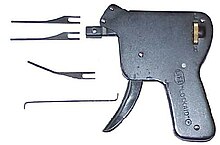Snap gun
This article needs additional citations for verification. (April 2019) |

A snap gun, also known as lock pick gun, pick gun, or electric lock pick, is a tool that can be used to open a mechanical
History
Louis S. Hanflig patented the first snap gun in the United States in 1934.[2] Subsequent designs were patented by Segal Samuel in 1943[3] and William J. Miskill in 1951.[4]
The earliest snap guns were developed to assist
Usage
A pin tumbler lock normally contains a set of bottom pins and a set of driver pins. The bottom pins move within pin channels inside the cylinder assembly and are cut at different lengths corresponding to the lock keying. The driver pins are installed in the lock housing and spring pressure forces them to penetrate the lock cylinder and prevent it from turning. If the wrong key is inserted, it will variously push the bottom pins either too high or not high enough, and the lock cylinder cannot turn. When the bottom pins are correctly aligned by the key, the top pins are exactly aligned with the barrel of the cylinder, and it may freely turn.
A traditional lock pick uses trial-and-error methods to find the correct alignment of the locking pins. The snap gun uses a primary law of
The same physical principles are involved in lock bumping, but the snap gun automates the transfer-of-energy process. A correctly applied snap gun can open a lock very quickly compared to traditional lock picking, but the sharp impact is more likely to damage the lock mechanism than raking, which mimics normal key movements.
References
- ^ ISBN 9780398083304. Retrieved April 12, 2019 – via Google Books.
- United States Patent Office. January 16, 1934. Retrieved April 12, 2019 – via Google Patents.
- United States Patent Office. February 2, 1943. Retrieved April 12, 2019 – via Google Patents.
- United States Patent Office. August 21, 1951. Retrieved April 12, 2019 – via Google Patents.
